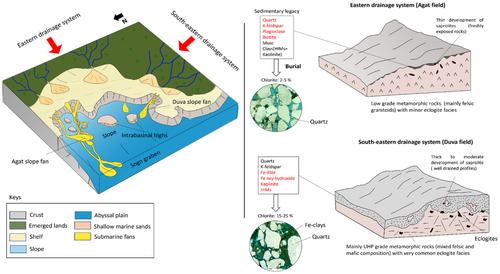当前位置:
X-MOL 学术
›
Basin Res.
›
论文详情
Our official English website, www.x-mol.net, welcomes your
feedback! (Note: you will need to create a separate account there.)
Impact of sediment provenance and depositional setting on chlorite content in Cretaceous turbiditic sandstones, Norway
Basin Research ( IF 2.8 ) Pub Date : 2024-05-15 , DOI: 10.1111/bre.12867 Fares Azzam 1 , Thomas Blaise 1 , Patricia Patrier 2 , Daniel Beaufort 2 , Jocelyn Barbarand 1 , Ahmed Abd Elmola 2 , Benjamin Brigaud 1 , Eric Portier 3 , Sylvain Clerc 4
Basin Research ( IF 2.8 ) Pub Date : 2024-05-15 , DOI: 10.1111/bre.12867 Fares Azzam 1 , Thomas Blaise 1 , Patricia Patrier 2 , Daniel Beaufort 2 , Jocelyn Barbarand 1 , Ahmed Abd Elmola 2 , Benjamin Brigaud 1 , Eric Portier 3 , Sylvain Clerc 4
Affiliation

|
Chlorite minerals, mainly in the form of clay coats, play a critical role in determining the reservoir quality of siliciclastic rocks. They can positively influence reservoir quality by preserving porosity during deep burial, but they can also play a negative role by reducing permeability through pore filling. The main aim of this research is to determine the optimal conditions for chlorite growth in sedimentary basins. This study investigates the Lower Cretaceous turbidite sandstone of the Agat Formation in the North Sea. We used a source‐to‐sink approach to investigate the impact of sediment source composition, chemical weathering and depositional environment on chlorite formation. Understanding the interplay between these processes can help refine exploration and exploitation strategies, optimise hydrocarbon recovery, and reduce exploration risks. Representative samples from two hydrocarbon fields (the Duva and Agat fields) were investigated using petrography, geochemistry, heavy mineral identification and quantification, and U–Pb geochronology of detrital zircons. Our results show a strong heterogeneity in the sediment provenance between the two turbidite systems. In the Duva field, the sandstone is derived from a mixture of mafic and felsic sources, producing Fe‐rich sediments. Intense chemical weathering generates fine fraction materials rich in kaolinite, vermiculite, and hydroxy‐interlayered clays, which are transported into shallow marine settings. Subsequent interaction with seawater results in the formation of glauconitic materials, Fe‐illite, and phosphatic concretions. These Fe‐rich materials are remobilised into deep marine settings, providing precursors for the development of authigenic Fe‐clays such as berthierine and chlorite. Conversely, in the Agat field, the sandstone is predominantly sourced from felsic rocks that underwent low chemical weathering, producing sediment rich in quartz and feldspar with a low amount of clays. With few Fe‐rich materials transported into the basin, the development of chlorite in the Agat field was less pervasive. Basin configuration and depositional environment exerted additional control on chlorite distribution. In the confined turbidite system (e.g. Duva field), chlorite is typically found as coating, whereas in less confined turbidite systems (e.g. Agat field) chlorite shows complex distribution related to depositional environment and dewatering processes. Our findings demonstrate the importance of considering the entire sediment routing system, from source to sink, when predicting chlorite occurrence and its impact on reservoir quality in deep marine settings. This integrated approach can guide exploration and development efforts in deepwater clastic reservoirs.
中文翻译:

沉积物来源和沉积环境对挪威白垩纪浊积砂岩中绿泥石含量的影响
绿泥石矿物主要以粘土层的形式存在,在决定硅质碎屑岩的储层质量方面起着至关重要的作用。它们可以通过在深埋过程中保留孔隙度来对储层质量产生积极影响,但它们也可以通过孔隙充填降低渗透率来发挥负面作用。本研究的主要目的是确定沉积盆地中绿泥石生长的最佳条件。这项研究调查了北海阿加特组的下白垩统浊积砂岩。我们采用从源到汇的方法来研究沉积物源成分、化学风化和沉积环境对绿泥石形成的影响。了解这些过程之间的相互作用有助于完善勘探和开采策略、优化碳氢化合物采收率并降低勘探风险。利用岩相学、地球化学、重矿物鉴定和定量以及碎屑锆石 U-Pb 地质年代学对两个油气田(Duva 和 Agat 油田)的代表性样品进行了研究。我们的结果表明两个浊积岩系统之间的沉积物来源存在很强的异质性。在 Duva 油田,砂岩来源于镁铁质和长英质的混合物,产生富铁沉积物。强烈的化学风化作用产生富含高岭石、蛭石和羟基层状粘土的细粒材料,这些材料被输送到浅海环境中。随后与海水的相互作用导致形成海绿石材料、铁伊利石和磷酸结核。这些富含铁的材料被重新融入深海环境中,为自生铁粘土(如贝蒂碱和绿泥石)的开发提供了前体。 相反,在 Agat 油田,砂岩主要来源于化学风化程度较低的长英质岩石,产生富含石英和长石以及少量粘土的沉积物。由于很少有富铁物质被输送到盆地,Agat 油田绿泥石的发育并不普遍。盆地构造和沉积环境对绿泥石分布施加了额外的控制。在承压浊积岩系统(例如 Duva 田)中,绿泥石通常作为涂层被发现,而在不太承压的浊积岩系统(例如 Agat 田)中,绿泥石表现出与沉积环境和脱水过程相关的复杂分布。我们的研究结果表明,在预测绿泥石的出现及其对深海环境中水库质量的影响时,考虑从源头到汇的整个沉积物路径系统的重要性。这种综合方法可以指导深水碎屑岩油藏的勘探和开发工作。
更新日期:2024-05-15
中文翻译:

沉积物来源和沉积环境对挪威白垩纪浊积砂岩中绿泥石含量的影响
绿泥石矿物主要以粘土层的形式存在,在决定硅质碎屑岩的储层质量方面起着至关重要的作用。它们可以通过在深埋过程中保留孔隙度来对储层质量产生积极影响,但它们也可以通过孔隙充填降低渗透率来发挥负面作用。本研究的主要目的是确定沉积盆地中绿泥石生长的最佳条件。这项研究调查了北海阿加特组的下白垩统浊积砂岩。我们采用从源到汇的方法来研究沉积物源成分、化学风化和沉积环境对绿泥石形成的影响。了解这些过程之间的相互作用有助于完善勘探和开采策略、优化碳氢化合物采收率并降低勘探风险。利用岩相学、地球化学、重矿物鉴定和定量以及碎屑锆石 U-Pb 地质年代学对两个油气田(Duva 和 Agat 油田)的代表性样品进行了研究。我们的结果表明两个浊积岩系统之间的沉积物来源存在很强的异质性。在 Duva 油田,砂岩来源于镁铁质和长英质的混合物,产生富铁沉积物。强烈的化学风化作用产生富含高岭石、蛭石和羟基层状粘土的细粒材料,这些材料被输送到浅海环境中。随后与海水的相互作用导致形成海绿石材料、铁伊利石和磷酸结核。这些富含铁的材料被重新融入深海环境中,为自生铁粘土(如贝蒂碱和绿泥石)的开发提供了前体。 相反,在 Agat 油田,砂岩主要来源于化学风化程度较低的长英质岩石,产生富含石英和长石以及少量粘土的沉积物。由于很少有富铁物质被输送到盆地,Agat 油田绿泥石的发育并不普遍。盆地构造和沉积环境对绿泥石分布施加了额外的控制。在承压浊积岩系统(例如 Duva 田)中,绿泥石通常作为涂层被发现,而在不太承压的浊积岩系统(例如 Agat 田)中,绿泥石表现出与沉积环境和脱水过程相关的复杂分布。我们的研究结果表明,在预测绿泥石的出现及其对深海环境中水库质量的影响时,考虑从源头到汇的整个沉积物路径系统的重要性。这种综合方法可以指导深水碎屑岩油藏的勘探和开发工作。






























 京公网安备 11010802027423号
京公网安备 11010802027423号